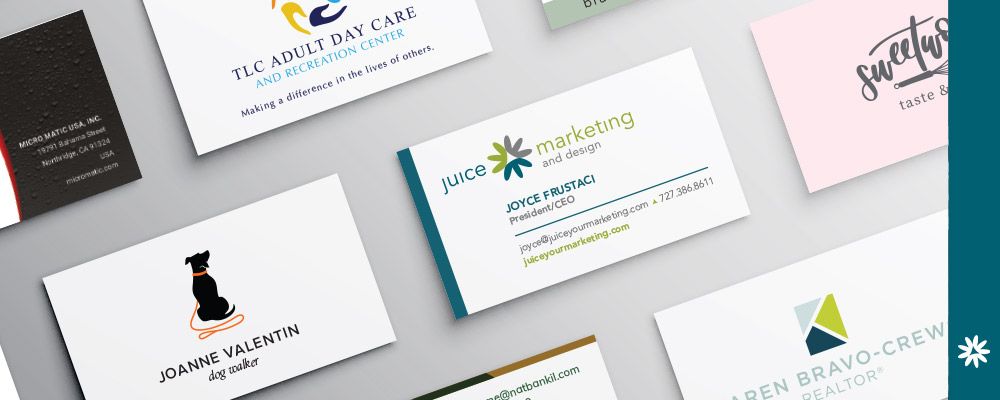Professional business cards are extremely important. They represent so much more than just your phone number or email address. From making a first impression to helping your potential clients understand your business at a glance, your business cards serve many purposes.
So, what makes a good business card? How can you make sure you’re harnessing the full potential of this tiny-but-mighty piece of marketing material? Here are ten things everyone should keep in mind.
-
Who, What, Where, Why?
Your business cards have limited space. Use that space wisely. Business cards are simply a point of contact, a way to show the recipient how they can find more information. A business card is not a brochure, so be sure to keep the content to a minimum.
-
Keep It Simple & Easy to Read
Make sure your text is legible! If you want to add more words but would need to reduce the font size so they will fit, leave out the extra words. Clients need to be able to read your information at a glance, and they won’t do this if the text is too small to read. Our suggestion is that you use an 8 pt. font for your main text (that rule of thumb may need to be adjusted based on the font chosen since some fonts are more compressed than others). Typically, with an 8 pt. font, it’s large enough to read but still gives you room for white space (as long as you keep the content to a minimum!).
-
Utilize White Space
Embrace simplicity and white space! “White space” is not literally white, but it is rather blank areas of space. Blank space on your business cards helps the design feel airy and uncluttered. It allows the recipients to focus on the important details. Plus, for those who like to jot down notes on their cards, white space gives them area to do so.
-
Be Mindful of Margins
A margin is the space between the text or graphics and the cut edge of your business cards. If you find yourself adjusting margins to make them thinner, it may be a sign that there is too much information on your card. Try reducing the content instead of decreasing margins. Skinny margins may cause the design to look less professional. Also, design elements may be cut off during the printing process if margins are too thin since there is an allowed margin of error for cutting in the print industry.
-
Stay on Brand
Make sure your business card design is consistent with all of your other business material (website, logo, postcards, etc.). If all of your content matches or is consistent with your overall brand appearance, your business will stand out as being more professional. (See some of our design examples of professional business cards that stay on brand.)
-
Consider Paper Thickness
Yes, it may save a few pennies to use a thinner paper stock for business cards, but this is not a worthwhile tradeoff. Those who receive your business card will automatically associate qualities of the card with qualities of your business. So, it’s important to make sure the paper you use is a nice quality and has a certain amount of durability.
-
Spice It Up With Finishing Options
People receive a lot of business cards. Do what you can to make yours memorable in a good way! Experiment with different types of paper and finishes. There are lots of options for paper stock: linen, kraft paper, thick card stock, and many more. Finishes run the gamut as well—matte, glossy, velvet, uncoated, silk, and spot gloss, for example. There are even options to add foil or implement raised glossy portions for extra oomph. Be sure to ask your printer what options are available to you.
-
Add a Second Set of Eyes
Before sending your card to print, review the details several times! And after you’ve reviewed, send your design to someone else to check as well. Fresh eyes help catch typos, and it’s much better to find mistakes before printing or handing out hundreds of business cards. Becasue we hvae all sene that exmalpe fo how our bairsn wrok so a secnod set of eyse is vrey heplful.
-
Use a Professional Headshot
If you have a headshot on your card, make sure it’s a professional photo. Working with a professional photographer is the best way to ensure that you have a high-quality photo. While it may seem easier to save a photo from social media or take a selfie, the quality of such a photo is not high enough for printing. (Yes, we know the lighting in your car may seem ideal, but resist the urge.)
-
Print Professionally
It is possible to print business cards at home or at your local on-demand copy store, but the quality you receive from a professional printer who regularly produces business cards is superior. There are also many more options for unique features (like raised spot gloss or metallics!) and paper choices with a professional printer.
As you make decisions about your business cards, remember: your business cards represent your business, even well after the initial introduction. Make sure they align with your values and your commitment to quality.
Whether you want to start over with a new business card design or you want to know more about print options to help your business card stand out, give Juice a call: 727-386-8611. Since we design and print, we would love to utilize both to help you make a great first impression with your business cards!

